Final report: Evaluation of coherence across Diplomacy, Trade and International Assistance in the Sub-Saharan Africa Branch (WGM) 2014-2015 to 2018-2019
Diplomacy, Trade and Corporate Evaluation Division (PRE)
Global Affairs Canada
August 2019
Table of contents
List of acronyms
- ACCRA
- The High Commission of Canada to Ghana
- ADM
- Assistant Deputy Minister
- CIDA
- Canadian International Development Agency
- CEFM
- Child, Early and Forced Marriage
- DFAIT
- Department of Foreign Affairs and International Trade
- DG
- Director General
- FIAP
- Feminist International Assistance Policy
- GAC
- Global Affairs Canada
- GC
- Government of Canada
- GE
- Gender Equality
- HOM
- Head of Mission
- IFM
- International Security and Political Affairs Branch
- JBURG
- The High Commission of Canada Trade Office, Johannesburg
- KFM
- Partnerships for Development Innovation Branch
- KNSHA
- The High Commission of Canada to the Democratic Republic of Congo
- OECD
- Organization for Economic Co-operation and Development
- PRE
- The Diplomacy, Trade and Corporate Evaluation Division
- PRET
- The High Commission of Canada to South Africa
- MFM
- The Global Issues and Development Branch
- MPUTO
- The High Commission of Canada to Mozambique
- NMS
- Mission Support Division
- SDGs
- Sustainable Development Goals
- WPS
- Women, Peace and Security
- WGM
- Sub-Saharan Africa Branch
Executive summary
Approximately six years post-amalgamation, Senior Management at Global Affairs Canada is increasingly interested in, and advocating for, coherent policies, programs and processes across the Department’s major lines of business: diplomacy, trade and international assistance. Coherence is seen as an important contributor to increased effectiveness and improved results across the Department.
This is the first from a series of planned evaluations assessing coherence at the branch level at Global Affairs Canada. As such it sets the stage for exploring the value added of bringing diplomacy, trade and international assistance under one department. Consular Services, although a departmental business line, was not included in the scope of this evaluation.
Due to a lack of performance measures and indicators for coherence, the evaluation adopted an experimental approach using score cards for six key organizational elements enabling coherence: policy alignment, organizational structure, leadership, roles and responsibilities, communications, and systems and processes.
This report presents the evaluation’s findings, conclusions and recommendations related to the state of coherence in the Sub-Saharan Africa Branch, as well as considerations for horizontal learning across the Department.
Overall, the evaluation found that the Sub-Saharan Africa Branch has made considerable efforts toward achieving organizational coherence. The Branch has developed frameworks and strategies to document a shared vision across business lines, and has initiated opportunities for cross-stream learning.
Departmental policies governing the work of the three business lines over the past six years have presented multiple opportunities for cross-stream collaboration. For example, the introduction of Canada’s feminist foreign policy has made gender equality a common priority across business lines.
Branch Senior Managers are widely regarded as champions for coherence at both headquarters and missions throughout the region. Their leadership and consistent messaging of the need to consult and collaborate with colleagues from other business lines have contributed to the Branch’s ability to identify and leverage synergies.
This report highlights examples of successful cross-stream collaboration, as well as initiatives and innovative approaches that have leveraged the expertise of different business lines. Along with pointing out best practices, the evaluation also identifies areas of untapped potential for collaboration, as well as department-wide challenges in pursuing more coherent international engagement.
The evaluation also highlights a number of factors hindering WGM’s ability to effectively leverage synergies across business lines, many of which were found to be outside the Branch’s remit. For example, the three business lines report to separate ministers and against distinct Performance Information Profiles (PIPs) that do not encourage cross-stream collaboration. Additionally, different time horizons, approval processes, and planning and reporting tools for each of the three business lines were frequently referenced as impeding branch-wide coherence efforts.
Summary of recommendations
It is recommended that WGM Senior Management:
1: Continue to reinforce Branch-wide expectations of cross-stream engagement, and continue to communicate to all staff a shared vision of how they are to be operationalized.
2: Continue to plan and implement initiatives that foster and incentivize cross-stream learning and innovation across the Branch.
3: Collect results on joint efforts to better enable the identification of synergies achieved in the Branch and feed this into the WGM Data Plan.
Background and context
Background: Amalgamation
Six years have elapsed since the passing of Bill C-60, which formalized the merger of Canada’s former International Development Agency (CIDA) and Department of Foreign Affairs and International Trade (DFAIT) into one department, now known as Global Affairs Canada (GAC). The 2013 Economic Action Plan asserted that while the new department would continue to deliver the functions of former CIDA and DFAIT, the merger would create opportunities for greater policy and programming coherence in addressing international priorities, thus leading to greater overall impact of Canada’s efforts.
Senior management’s focus on coherence
The merger of former CIDA and DFAIT incited a broad-based recognition of the need to increase collaboration across diplomacy, trade and international assistance. Various departmental plans and reports have since articulated the importance of integrated policy and programming for the achievement of results post-amalgamation. Coherence has become an ongoing topic of discussion for Global Affairs’ senior managers, who are now actively advocating for improved coherence of departmental policies, programs, and processes. A particular focus is being placed on the identification and leveraging of synergies across the three business lines: international assistance, diplomacy and trade. Consular services, although also a business line, was not examined in the scope of this evaluation.
The amalgamation of former-CIDA and DFAIT was in line with a broader trend among OECD countries to merge development agencies with departments of foreign affairs and/or trade. Australia, Norway, and the Netherlands are among the countries that have amalgamated aspects of their diplomacy, trade and international assistance programs under a single institution to support more coordinated and coherent international engagement. Though there has been no standard model or experience for institutional amalgamation, a number of common challenges were identified across countries, such as the integration of different corporate cultures, misaligned time horizons, and separate planning and reporting processes.
“In amalgamating CIDA and DFAIT, Canada chose a deep integration approach in which management of international assistance was integrated in the department’s existing branches. This has improved the coherence of Canada’s approach to foreign policy, international trade, development, and peace and security. In addition, the department’s organizational structure and integrated governance framework appear to be working well.”
Evaluation rationale and methodology
Rationale
In line with Senior Management’s interest in organizational coherence, each of the Department’s four geographic branches is planned to undergo a branch level coherence evaluation.
While coherence can be assessed at different levels of an organization (i.e. government, department, branch or program level), evaluation at the branch level allows for a comparison of both best practices and challenges in implementing coherent policies and programs across the Department’s four geographic braches.
This is the first evaluation of coherence in the Department. As such, it offers a learning opportunity and denotes the challenge of defining coherence and measuring its contribution to improved results across diplomacy, trade and international assistance.
Purpose
The purpose of this evaluation was to assess the degree to which key elements of organizational coherence were in place within WGM to enable effective coordination and collaboration across business lines. The evaluation sought to identify factors that incentivize coherence, thus serving as a catalyst for future discussions and planning purposes across the Department.
Scope
The evaluation assessed the coherence of diplomacy, trade and international assistance (including development, humanitarian and security assistance) across WGM’s Headquarters (HQ) and its 16 diplomatic missions in Sub-Saharan Africa from FY2014-15 to FY2018-19.
Other functional, corporate and geographic branches were consulted on areas related to the scope of the evaluation to provide a broader, Department-wide understanding of the cultural and organizational factors that promote or inhibit coherence across business lines at the branch level.
Overview of WGM’s Organizational Structure
WGM engages with 48 countries in the region, has 16 missions and 5 offices, and is organized under 3 bureaus.
West and Central Africa Bureau (WWD) and Southern and Eastern Africa Bureau (WED)
The 2 geographic bureaus are responsible for managing bilateral relations (political, trade and development) between Canada and accredited countries, and deliver 13 development programs in Sub-Saharan Africa.
Pan-Africa Bureau (WFD)
The bureau is responsible for managing Pan-African regional and institutional relationships, providing analysis, delivering regional policy and multi-country development programming initiatives, and engaging in strategic and operational planning and coordination for the entire branch. In addition, the DG of the bureau has a special role as the Trade Champion for the Branch.
Defining coherence
The concept of coherence has become increasingly prominent in recent years due to a recognition that the growing complexity and interconnectedness of global challenges requires coordination across multiple lines of effort. Coherence has been defined, operationalized, and assessed differently based on the areas of focus and types of policies and initiatives under review. For this reason, there has been no standard definition of what coherence entails or what it is ultimately intended to achieve.
Based on scoping interviews and literature review, coherence, for the purpose of this evaluation, was defined as:
“an enabler for identifying and leveraging synergies across diplomacy, trade and international assistance in the Sub-Saharan Africa Branch, ultimately contributing to increased efficiency and better results in Canada's international engagement.”
By working closely together, the three business lines are expected to mutually reinforce their strengths and avoid working at cross-purposes.
Evaluating coherence
Program evaluation within the Government of Canada generally assesses core issues of relevance and performance, guided by clear logic models or theories of change, and measurable performance indicators. As organizational coherence is neither a program nor initiative with pre-defined outcomes or clear linkages between activities and results, the standard approach to evaluation could not be applied.
Measuring progress toward improved coherence was challenging due to a lack of comparable data. As a proxy measure, the evaluation used scorecards to indicate the extent to which key organizational elements were in place and facilitated engagement across business lines.
Key organizational elements
For the purpose of this evaluation, an internal review focussed on six organizational elements, inferring that each enables improved coherence across business lines. These elements were selected based on scoping interviews with program managers and extensive document review on organizational coherence.

Policy Alignment
The alignment and complementarity of departmental policies governing the work of the Branch.

Organizational
The Branch’s organizational structure and its impact on Branch communications, coordination and collaboration.

Leadership
The role of Branch Management (senior and middle management) in fostering communication, coordination, and collaboration across business lines.

Roles & Responsibilities
Staff’s understanding of the different roles and responsibilities across business lines and how they relate to one another.

Communications
The practices and channels in place to support the sharing of information and collaboration across business lines.

Systems & Processes
The compatibility of information management, and planning and reporting systems and processes.
Data collection methodology
The evaluation used a mixed-method approach, drawing on several lines of qualitative and quantitative data sources to maximize the reliability of findings.
Document & literature review
The evaluation team examined branch and departmental reports, statements, reviews and databases, and conducted a broad literature review on policy and organizational coherence.
In person interviews and field visits
Semi-structured interviews were conducted with over 150 key stakeholders at HQ and missions with direct experience working in or closely with WGM’s diplomacy, trade or international assistance programs.
A significant portion of the interviews (59%) were conducted at four missions in Sub-Saharan Africa, along with direct on-sight observations: South Africa, Mozambique, the Democratic Republic of Congo and Ghana.
Evaluators capitalized on the field visits by meeting other government departments (OGDs) co-located at mission to obtain their perspectives on policy and programming coherence at missions. The evaluation team also met with representatives of like-minded countries to discuss how they ensure consistency and complementarity of their foreign policy, trade and development priorities.
Survey of WGM staff (HQ & Missions)
Finally, an electronic survey was sent to 214 locally-engaged staff (LES) and Canada-based staff (CBS) working for the Branch across the three business lines at missions and at HQ. In total, 137 contacts responded to the survey for a 64% completion rate. Responses were filtered by business line, location (mission vs. HQ), type of development program (centralized vs. decentralized), and classification levels to assess potential trends and differences.
Breakdown of Interview Stakeholders:
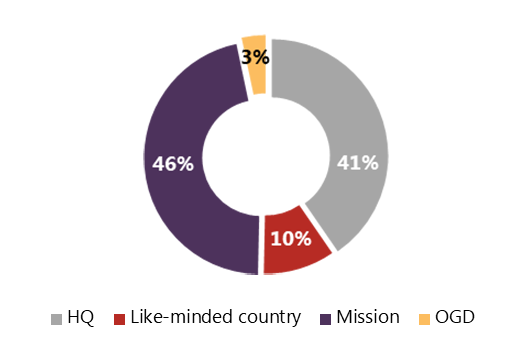
Text version
A pie chart separates interview stakeholders into four categories:
1. Interviewees at Global Affairs Canada’s Headquarters, representing 41% of all interviewees;
2. Like-minded country interviewees, representing 10% of all interviewees;
3. Interviewees at Global Affairs Canada’s diplomatic missions abroad, representing 46% of all interviewees; and
4. Interviewees from other Government of Canada departments and agencies, representing 3% of all interviewees.
Breakdown of Survey Respondents by Business line:
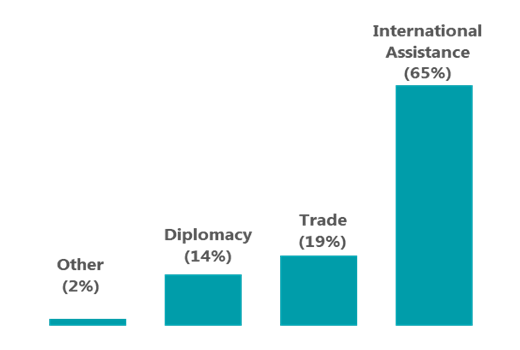
Text version
A column graph demonstrates the percentage of survey respondents by their respective business lines:
1. The first and smallest bar (far left) is “other”, representing 2% of all respondents;
2. The second bar is “Diplomacy”, representing 14% of all respondents;
3. The third bar is “Trade”, representing 19% of all respondents; and
4. The last and highest bar (far right) is “International Assistance”, representing 65% of all respondents.
Data analysis methodology
Each of the six identified organizational elements were assigned a score based on the weight of supporting evidence collected through multiple lines of inquiry. These scorecards were intended to highlight areas in which the Branch is positioned for cross-stream engagement, as well as those requiring further efforts to enable business lines to identify and leverage synergies.
Scorecards were prepared for the following organizational elements:
- Policy Alignment
- Organizational Structure
- Leadership
- Roles & Responsibilities
- Communications
- Systems & Processes
Each of the key organizational elements were examined and received a scorecard similar to the Policy Alignment example below.
Example: Scorecard for organizational elements

Text version
Top row of the scorecard table: Policy Alignment: The alignment and complementarity of departmental policies governing the work of the Branch.
Second row of the scorecard table: There are three potential scores that the Branch could receive for Policy Alignment. They are presented as three separate columns in the second row of the scorecard table:
1. Far left column - No alignment of departmental policies across business lines within the Branch.
2. Middle column - Partial alignment of departmental policies across business lines within the Branch. This box is highlighted purple to demonstrate that this is the score the Branch received.
3. Far right column - Complete alignment of departmental policies across business lines within the Branch.
The third and final row of the scorecard table reads: Rationale: here we will substantiate scores based on findings and the weight of supporting evidence.
Evaluation findings
Finding 1. Post-amalgamation, the Sub-Saharan Africa Branch has made concerted efforts to promote integration and enhance its capacity to locate and leverage synergies across business lines.
Historically, Canada’s relationships with countries in Sub-Saharan Africa have been vast and diverse. In broad terms, the Sub-Saharan Africa Branch has long provided development assistance, promoted democracy, and peace and security, and has fostered increased commercial and economic ties with countries in the region.
The Branch’s work cuts across several different mandates and services distinct beneficiaries. As an early effort to promote and facilitate a coherent approach to international engagement in the region, WGM was the first geographic branch at Global Affairs to fully integrate diplomacy, trade and international assistance policies and programs at the Director General (DG) level post-amalgamation.
Between 2013 and 2018, a series of initiatives were implemented to improve coherence across WGM’s lines of business. Additionally, various instruments were developed to guide staff on how they could work together to achieve common goals.
For example, in 2015, WGM introduced its Strategic Framework to Guide the Work of Sub-Saharan Africa Branch. The document was developed as an overarching positioning piece to assist all business lines in their efforts to capitalize on the potential of the newly amalgamated branch.
In 2018, this was superseded by a document on Canada’s Strategic engagement in Sub-Saharan Africa which, though not officially approved, reflected new policy directions and integrated all business lines under a common approach.
The Branch also established the Africa Trade and Development Advisory Group to periodically convene external experts to discuss synergies between the two business lines, and launched the Africa Policy Network in 2016 as a forum to promote policy coherence and knowledge sharing across the Branch. A series of working group meetings were also held during this time period to engage employees at mission and HQ on key multipliers, innovative approaches, and ways to build and sustain partnerships.
WGM collaborated with the Strategic Policy Branch (PFM) to develop a Trend Analysis for the region which resulted in 12 foundational papers, a synthesis paper, and a high-level panel. The Branch also developed a series of action plans to strengthen engagement across key nexus areas (i.e. trade-development and security-development).
These and other initiatives made coherence a clear priority within the Branch. Survey and interview data also corroborated that organizational coherence has become a clear priority for WGM Senior Management at both HQ and missions.
“Synergy refers to the interaction of different elements (sectors, streams, initiatives and programs) to produce a combined impact that is greater than the sum of its individual parts. DFATD recognises the transformative power of synergies, both in terms of how we work and what we prioritize. Promoting synergies is at the heart of amalgamation efforts, as DFATD streams seek new ways to deploy DFATD trade, development and diplomatic assets to achieve Canadian foreign policy objectives.”
Finding 2. Departmental policies governing the work of diplomacy, trade and international assistance articulated common priorities across business lines and presented opportunities for cross-stream collaboration.
Departmental policies in place throughout the evaluation reference period were found to be complementary and conducive to the identification of potential linkages across business lines. For example, in the early years of amalgamation, the Global Markets Action Plan (GMAP) outlined opportunities for cross-stream engagement by advocating for “economic diplomacy” and the promotion of trade through international diplomatic networks. The GMAP included priority sectors that aligned with Canada’s international assistance priorities in the region, such as education, infrastructure, sustainable technologies, agriculture, and mining.
In addition, the Sustainable Economic Growth Strategy highlighted the links between trade and development through its focus on building economic foundations and growing businesses in developing countries to create employment opportunities. One of the areas of focus under the Strategy was on extractives programming to support better governance of natural resources and greater participation of beneficiary communities. These objectives converged with trade priorities for improved enabling environments through private sector corporate social responsibility (CSR) initiatives.
Canada’s Feminist Foreign Policy
The Government of Canada’s current Feminist Foreign Policy, comprised of the Feminist International Assistance Policy (FIAP) and the National Action Plan on Women, Peace and Security, as well as the gender focus in the Progressive Trade Agenda and Defense Policy, provided a series of complementary policies around gender equality. Both departmental and branch-level Senior Management defined gender equality as a priority for all business lines and encouraged staff to apply a feminist lens to their work.
FIAP’s Inclusive Governance action area was cited by interviewees as an area for strengthening the linkages between diplomacy and international assistance through joint advocacy work on human rights and the rule of law. While the Growth that Works for Everyone action area encouraged trade and development to work together to promote opportunities for women in business, interviewees lacked clarity on how the trade program was expected to apply a feminist lens to its engagements abroad.
Foreign Policy Priorities (FY 2014-2015 to FY2017-2018)
| FY 2014-2015 | FY 2015-2016 | FY 2016-2017 | FY 2017-2018 |
|---|---|---|---|
| Government of Canada | |||
| Official Development Assistance Act – Poverty reduction focus | |||
| 2030 Agenda for Sustainable Development (Sustainable Development Goals -SDGs) | |||
| Gender Based Analysis + (GBA+) | |||
| G7 Muskoka Initiative - MNCH | |||
| Paris Climate Agreement | |||
| Action Plan for the Implementation of United Nations Security Council Resolutions on Women, Peace and Security - 2010-2016 | National Action Plan on Women, Peace and Security 2017- 22 | ||
| Global Affairs Canada | |||
| Global Markets Action Plan/Progressive Trade Agenda | |||
| Sustainable Economic Growth Strategy (SEG) Food Security Children and Youth | Feminist International Assistance Policy | ||
[1] Muskoka Initiative was from 2010 to 2015 to support Maternal, Newborn and Child Health (MNCH). GAC continues to do programming on MNCH.
[2] The Global Markets Action Plan is still in effect even with the progressive trade agenda
Finding 3. The Branch’s integrated organizational structure supported coherent international engagement. However, the upstream departmental reporting structures and stream-specific Performance Information Profiles were deemed to hinder effective cross-stream collaboration.
WGM’s organizational structure
Broadly speaking, interviewees felt that the post-amalgamation reorganization of diplomacy, trade and international assistance under the level of the Directors General facilitated greater coherence. The reorganization resulted in each of the Branch’s three bureaus having responsibility for all three major business lines. WGM was the first branch to reorganize itself in this way.
Staff generally felt that this structure worked well due to the regional context and the Branch’s stronger focus on development, commensurate with its resources. This may, however, have also contributed to the perception of limited time being allotted to diplomacy and trade.
WGM’s trade champion
The creation of a Trade Champion for WGM (the DG for the Pan-Africa Affairs Bureau) was considered important for the promotion of trade opportunities within a Branch predominately focussed on international development. Multiple interviewees stated that having a DG who was well-versed in trade was highly beneficial for ensuring that trade was visible and understood among Branch employees.
Operational challenges
Interviewees noted that while organizational and cultural divides across business lines had improved in the years following amalgamation, disparate beneficiaries, mandates, and timelines remain an operational challenge to a cohesive whole-of-Department approach. According to some interviewees, however, the distinct mandates should not be seen as an inherently negative feature, underscoring the importance of preserving each business line’s unique function as essential for its overall success.
Some of the quoted operational challenges included trade officers’ primary focus on pre-determined Key Performance Indicators (KPIs), and development’s heavy approval processes, investment plans, and budgets, which are often perceived as being opaque. In addition to the various operational challenges that were seen as hindering cross-stream collaboration, interviewees also noted a lack of incentives to seek out and work on initiatives outside of their individual mandates. In addition, departmental approaches, such as having to report against distinct Performance Information Profiles by stream, also hindered coherence. To address these, WGM developed a document on Canada’s Engagement in Africa and a subsequent narrative to operationalize coherence through integrated objectives.
“Global Affairs Canada should resolve the remaining amalgamation challenges by further fostering a shared culture across the department, and by continuing to harmonize and streamline departmental systems and processes….Silos prevent the exchange of information and collaboration within Global Affairs Canada.”
“The fact that the DG-level is accountable for three business lines ensures a good degree of interaction. However, when we have management meetings with HOMs, Directors, DGs - 80% of the discussions are focussed on development issues or ministerial visits. We rarely talk about trade or purely diplomatic issues.”
Finding 4. The small footprint of WGM’s trade and diplomacy functions in Sub-Saharan Africa has limited the Branch’s ability to capitalize on growth opportunities for trade, and on broader policy and advocacy engagement in the region.
International assistance is, and historically has been, the dominant focus for Canada’s international engagement in Sub-Saharan Africa. The Government of Canada has committed to provide no less than 50% of all bilateral international assistance to the region by 2021-22. As a result, WGM delivers approximately $625M annually in international assistance, which requires the commensurate proportion of Branch time and resources to be dedicated to implementation.
While the region continues to be home to the majority of the world’s poorest and most vulnerable, many African countries have made sizeable gains in improving governance, security and economic growth. This has opened opportunities for Canada’s trade and diplomatic engagement in the region beyond international assistance. Due to limited resources for trade and diplomacy, however, the Branch has been constrained in its ability to fully capitalize on these opportunities.
For example, there are currently only nine senior trade commissioners (STCs) at Canada’s missions in Sub-Saharan Africa with a collective responsibility for trade in 48 countries. Though STC profiles were reorganized in 2017 to establish workload equity, there was a general consensus among WGM staff that both STCs, and the trade commissioners working under them, remained overstretched in the region. The trade program in Sub-Saharan Africa continues to be inadequately resourced, leaving trade commissioners with little time to work outside their immediate mandates and countries. This detracts from their ability to capitalize on the potential of the region and leverage synergies with other business lines and missions.
According to the International Monetary Fund (IMF), Africa is one of the fastest growing economic regions in the world. This presents tremendous trade and investment opportunities in Sub-Saharan Africa and reinforces the need for business lines to work collaboratively.
“The trade relationship is one of the fastest growing areas of the Ghana–Canada relationship and I am pleased that it is growing not just in terms of Canadian export to Ghana but also Ghanaian export to Canada.”
Finding 5. While formal committees and regular meetings were established to facilitate overall cross-stream coordination and information-sharing, informal communication channels remained an important mechanism at the working level.
WGM staff made concerted efforts to consult and share information across business lines, and between missions and HQ. In an effort to ensure consistency in consultation and tasking processes, the Branch developed a guidance document that clearly outlined the leads and approval levels for each corporate tasking.
At HQ, regular branch and bureau meetings allowed staff to share information across business lines and with missions abroad. These included weekly ADM Stand-up meetings, bi-annual all-staff meetings, annual regional HOM meetings, and senior management meetings.
Similar to HQ, missions also held meetings to share information across business lines. These meetings were often extended to include other government department representatives in order to facilitate a more cohesive whole-of-Government approach to engagement in host countries. Interviewees indicated, however, that most of the meetings were held at the management level, and that information discussed, and often pertinent to cross-stream engagement, was not always shared with the working level.
At the working level, most staff indicated a reliance on informal channels and relationships for cross-stream collaboration and information sharing. While informal methods appear to have worked well in terms of short-term coordination, the reliance on such channels has created challenges for maintaining corporate memory and ongoing coordination due to rotationality. According to the 2018 HR Dashboard, 83% of positions in the Branch were classified as rotational or mobile.
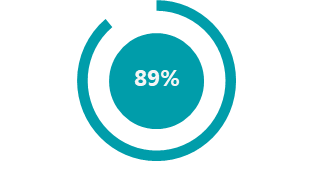
The majority of survey respondents (89%) stated that working with other business lines is important for the success of their work.

The majority of survey respondents (86%) reported that they have a working relationship with colleagues in different business lines.
Finding 6. Communication and collaboration between WGM and other branches with programming activities in Sub-Saharan Africa has considerably improved, but some challenges for effective inter-branch cooperation remain.
WGM has made concerted efforts to promote inter-branch communication and collaboration through strategic products, such as country narratives, factsheets, and International Assistance Snapshots. The development of HOM Letters and Country Vision Statements was also seen to have contributed to closer inter-branch consultation and a more unified vision for Canada’s international engagement in each country across the region.
WGM is regularly included in the Partnerships for Development Innovation Branch’s (KFM) Call for Proposals selection processes, and co-chairs a departmental working group on Maternal, Newborn and Child Health and Sexual and Reproductive Health Rights with the Global Issues and Development Branch (MFM). These examples demonstrate the importance and benefits of inter-branch coherence.
There was a strong consensus among WGM staff, however, that up-to-date information on country-specific projects, investments, and contributions had not been consistently shared across branches. This was felt to significantly detract from WGM’s ability to work coherently with other branches. Interviewees emphasized the need for regular consultations and coordinated planning in international assistance, citing it as a necessary condition for improved departmental coherence.
This issue was mainly raised with respect to WGM’s engagement with the Global Issues and Development Branch and the Partnerships for Development Innovation Branch. While tracking sheets for projects and initiatives have been developed, they have not always been reflective of the most recent information.
An additional challenge raised was the different perspectives across branches on certain international assistance-related issues in the region. This was raised most often in regards to collaboration between WGM and the International Security and Political Affairs Branch (IFM).
Departmental exercises, such as Integrated Country Frameworks (Burkina Faso, Ghana, Senegal, South Sudan, South Africa, Mali) and Integrated Conflict and Fragility Analyses (Mali, South Sudan) have facilitated strategic thinking, and have supported coherence and transparency across business lines and branches. Such processes can provide a platform for articulating and sharing business line-specific priorities and are entry points for cross-stream engagement; however, they do come at a cost in terms of level of effort and coordination.
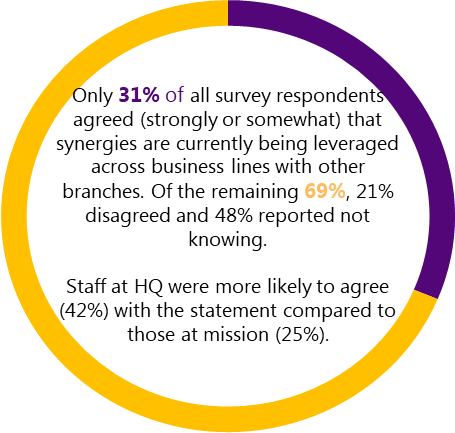
Text version
A doughnut infographic shows 31% of a full circle outlined in purple and the remaining 69% outlined in yellow. The following text appears inside the circle: Only 31% of all survey respondents agreed (strongly or somewhat) that synergies are currently being leveraged across business lines with other branches. Of the remaining 69%, 21% disagreed and 48% reported not knowing.
Staff at HQ were more likely to agree (42%) with the statement compared to those at mission (25%).
Finding 7. Branch senior managers were seen as champions for promoting coherence across business lines. However, there was a perceived lack of operational guidance, both within the Branch and the Department, on how business lines should work together in practice.
WGM staff at missions and HQ generally agreed that branch senior managers were champions for promoting coherence. At HQ, this was demonstrated through their consistent messaging that business lines should work in a consultative and collaborative manner, and that branch materials should be coherent and reflective of all business lines. Interviewees noted that efforts had been made by the ADM and DGs to share business-line specific information and achievements with all staff through branch-wide forums.
At missions, coherence was reinforced through the HOM mandate letters issued by the ADM, which outlined the Branch’s expectations that HOMs integrate and promote coherence across programs at mission. HOMs were widely-regarded as key driving forces for incentivizing collaboration and cultivating coherence at missions. Staff across business lines commended their HOMs for their ability to identify linkages, ensure the realization of synergies, and encourage staff to think from a whole-of-Government perspective.
While it was apparent that Branch management (senior and middle management) expected staff to work together coherently, there was a perceived lack of operational guidance on how staff was expected to do so in practice. A majority of WGM interviewees at both HQ and missions expressed a desire for greater direction on areas of complementarity between business lines, and clarity on how they were expected to work collaboratively while still maintaining operational independence and delivering on their business line-specific mandates.

78% of all survey respondents agreed that WGM Senior Management clearly articulates the branch’s vision and priorities for engagement across the three business lines. Those at HQ were more likely to agree (72%) compared to those at mission (50%).
“You have to change mindsets. The ability to have greater coordination and synergy depends on the individuals involved and the leadership at the top (e.g. HOM). There is a need to socialize the concept.”
“HOM wears the hat and spirit of coherence. (S)he is responsible not only for the functioning of the mission, but also for identifying synergies across sections. The previous HOM was encouraging collaboration, and our current HOM is reinforcing the benefits of joint engagement.”
Finding 8. WGM staff had a broad overall understanding of the distinct roles and responsibilities of other business lines, both at missions and HQ.
WGM staff were generally aware of the roles and responsibilities of other business lines and bureaus across the Branch, both at HQ and missions, but lacked a detailed awareness of specific files or projects outside their respective business lines. While expressing an interest in better understanding the work of other streams, WGM staff generally felt that an in-depth understanding of their projects and initiatives was not necessarily a condition for enhanced cross-stream engagement.
WGM staff’s general awareness of roles and responsibilities across the Branch was advantageous in that it assisted the Branch in identifying and capitalizing on several new opportunities, and prevented some duplications of work and inefficiencies. Much of this was attributed to Senior Management’s efforts, at both HQ and missions, to organize training and information sessions aimed at the promotion of greater awareness and understanding of the priorities of different business lines.
For example, as part of its annual training plans, WGM organized, together with the Canadian Foreign Service Institute, a course entitled “Africa at a Cross-Roads” (2018) which highlighted international assistance, trade and diplomacy trends and priorities throughout the region. The Branch also organized thematic training sessions with cross-stream participation from HQ and the field.
Pan-Africa Affairs Bureau
The Pan-Africa Affairs Bureau was created post-amalgamation to promote policy and operational coherence in the Branch’s engagement in Sub-Saharan Africa. The bureau is responsible for managing Pan-African regional and institutional relationships, providing analysis, delivering regional policy and development programming initiatives, and engaging in strategic and operational planning and coordination for the entire Branch.
The Bureau has made considerable efforts to raise awareness among branch staff of the roles and responsibilities of its three divisions. The Pan-Africa and Regional Development Division created a vision placemat accompanied by a narrative to clarify its role and responsibilities, while the Pan-Africa Affairs Division prepared presentations for new employees.
Despite these efforts, a significant number of interviewees reported a lack of clarity with regard to the Bureau’s roles and responsibilities. For example, some staff noted a lack of awareness of Pan-Africa Affairs’ lead role on thematic policy areas for the Branch, and its work on strengthening “nexus areas” involving the three business lines.
Proportion of survey respondents that agreed (strongly or somewhat) with the following statement:
“I know who to contact from each of the three business lines if there are links with my files.”

Text version
Two separate progress bar infographics are used to demonstrate that 87% of survey respondents at missions abroad, and 64% of those located at headquarters agreed (strongly or somewhat).
Finding 9. The multiplicity of departmental information management, and planning and reporting systems, tools, and processes used across the different streams was identified as an impediment to integrated planning and reporting.
WGM has made significant efforts toward establishing a consultative and collaborative approach to information sharing and integrated planning and reporting across the Branch. Branch planning commitments were developed through consultations with all business lines, and were included in Strategia to help inform forward planning. They also form the basis for staff Performance Management Agreements (PMAs). However, the current plethora of departmental systems, tools, and processes tailored to individual business lines was identified as a challenge for cross-stream engagement.
The evaluation also identified a lack of consistency in the use of information management platforms across the Department. Diplomacy, trade and international assistance programs each use different reporting platforms, namely Strategia, TRIO, FAS, MyInternational, Horizons, EDRMS and InfoBank, to capture and report on data, and share information. Numerous interviewees identified the lack of compatibility among these tools as a major impediment to information-sharing and collaboration.
Upstream coherence
WGM operates in a broader departmental structure that requires the three business lines to report to separate ministers and against distinct Performance Information Profiles (PIPs) with different indicators for high-level results feeding into the Departmental Results Framework (DRF). There was a perceived need for improved upstream integration to facilitate collaboration across business lines and to capitalize on branch-level efforts toward coherent engagement.
To mitigate some of the above raised issues, WGM took the initiative to ensure that the Sub-Saharan Africa Narrative articulated coherent objectives to reduce the effects of structural siloes. The Branch also proactively developed a single Integrated Risk Management Framework for the three PIPs.
“Amalgamation can only be a success over the long run if there are systems that allow for integration...”
WGM staff were asked whether they agreed with the following statement:
“Departmental reporting tools and systems are compatible across business lines at mission”
Survey responses revealed that only 36% of mission staff agreed (strongly or somewhat) and 27% of staff at HQ.
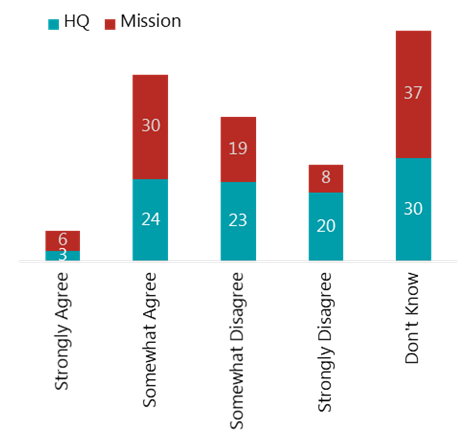
Text version
A stacked column chart is used to present, by the percentage of survey respondents from headquarters and missions that fall under each category, the extent to which respondents agree with the following statement: “Departmental reporting tools and systems are compatible across business lines at mission”.
1. 6% of mission respondents and 3% of HQ respondents strongly agree
2. 30% of mission respondents and 24% of HQ respondents somewhat agree
3. 19% of mission respondents and 23% of HQ respondents somewhat disagree
4. 8% of mission respondents and 20% of HQ respondents strongly disagree
5. 37% of mission respondents and 30% of HQ respondents don’t know
Finding 10. Synergies between trade, diplomacy and international assistance have emerged as a result of both strategic integrated planning and ad hoc initiatives. Due to a lack of baseline data, the evaluation was unable to ascertain whether this had led to greater efficiencies and results achieved.
The majority of WGM interviewees agreed that synergies were being leveraged across business lines at both HQ and missions. When asked to provide examples of business lines working horizontally to reach a common goal, staff frequently referenced events and official visits. Synergies around specific projects were less frequently referenced.
The evaluation identified a number of factors that impacted when, where, and the extent to which synergies were being leveraged across business lines. Staff’s physical proximity to colleagues in different business lines, individual personalities, and the enthusiasm of management were often felt to influence the Branch’s ability to identify potential synergies.
At the broader departmental level, several interviewees felt that the following factors hindered the Branch’s ability to leverage synergies:
- Policy and operational adjustments resulting from changes in government and/or departmental priorities;
- Challenges and opportunities resulting from the specific contexts of individual host countries. For example, conflict affected counties required more collaboration between diplomacy, security and development, but offered limited opportunity for trade involvement; and
- Different time horizons, approval processes, and programming terms and conditions for trade and development.
Though a range of synergies were identified, the evaluation was not able to objectively measure the degree to which they had generated greater outcomes. This was largely a result of business lines reporting separately on outcomes, as well as the perceived lack of incentives for them to report on synergies or joint efforts.
Nevertheless, the evaluation found several strong examples of joint efforts across business lines, and identified considerable untapped potential for future collaboration, particularly between trade and development.
Though WGM staff were generally aware of the potential benefits of amalgamation and were willing to work together across business lines, interviewees cautioned that coherence would not always result in win-win situations. Several interviewees felt that trade-offs were an inevitable consequence of cross-stream integration.
79% of survey respondents agreed that synergies were being leveraged at mission.
44% of survey respondents agreed that synergies were being leveraged within WGM more broadly.
Key Nexus areas identified by WGM staff
The evaluation found several examples of areas where WGM staff either worked together across business lines to reach a common goal, or identified opportunities for greater collaboration. Synergies have been leveraged as a result of both Senior Management’s insistence on the need to work collaboratively, as well as the individual initiatives of staff at the working level.

Text version
The Venn diagram depicts the interrelated nature of Global Affairs Canada’s three major lines of business: diplomacy, trade, and international assistance.
Four numbers appear in areas of overlap between two or all three circles of a Venn diagram.
Number 1 represents the Diplomacy-Trade Nexus. The evaluation identified the following areas of overlap for this nexus area:
- Women in Business/Trade
- Clean Technology and Renewable Energy
- Girls in Science, Technology, Engineering, and Mathematics Education
- Arts and Culture
- Creative Events (i.e. film festivals)
Number 2 represents the Diplomacy-International Assistance Nexus. The evaluation identified the following areas of overlap for this nexus area:
- Human Rights: Child and Early Forced Marriage, Sexual Reproductive Health and Rights, Sexual and Gender-Based Violence, Comprehensive Sexual Education
- Peace and Security
- Governance
Number 3 represents the Trade-International Assistance Nexus. The evaluation identified the following areas of overlap for this nexus area:
- Blended and Innovative Financing
- Education (i.e. Scholarships)
- Women’s Voice and Leadership
- Agriculture
- Natural Resource Management
- Domestic Resource Mobilization
- Technical Vocational Educational Training
Number 4 represents the Diplomacy-Trade-International Assistance Nexus. The evaluation identified the following areas of overlap for this nexus area:
- Women’s Economic Empowerment
- Election Monitoring
- Corporate Social Responsibility
- Climate Change
- Canada Fund for Local Initiatives (CFLI)
- Social Media
- Post Initiative Funds (PIF)
- La Francophonie
- Official Visits and Briefing Materials
1. The Diplomacy-Trade Nexus
- Women in Business/Trade
- Clean Technology and Renewable Energy
- Girls in Science, Technology, Engineering, and Mathematics Education
- Arts and Culture
- Creative Events (i.e. film festivals)
2. Diplomacy-International Assistance Nexus
- Human Rights: Child and Early Forced Marriage, Sexual Reproductive Health and Rights, Sexual and Gender-Based Violence, Comprehensive Sexual Education
- Peace and Security
- Governance
3. The Trade-International Assistance Nexus
- Blended and Innovative Financing
- Education (i.e. Scholarships)
- Women’s Voice and Leadership
- Agriculture
- Natural Resource Management
- Domestic Resource Mobilization
- Technical Vocational Educational Training
4. The Diplomacy-Trade-International Assistance Nexus
- Women’s Economic Empowerment
- Election Monitoring
- Corporate Social Responsibility
- Climate Change
- Canada Fund for Local Initiatives (CFLI)
- Social Media
- Post Initiative Funds (PIF)
- La Francophonie
- Official Visits and Briefing Materials
Examples of cross-stream engagement at mission
South Africa
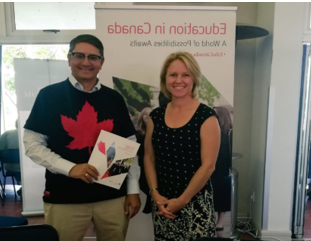
Trade and international assistance representatives from the High Commission of Canada in South Africa jointly promoted local funds for education, including the African Leaders of Tomorrow scholarship and the Francophonie scholarship program, both of which sought to provide opportunities to young leaders who could not afford education.
Mozambique

The High Commission of Canada in Mozambique (MPUTO) collaborated across business lines to plan a unique Canada Day celebration, which saw all staff contribute to raising funds for a local school in an impoverished area. In addition to fostering communication across business lines, the mission capitalized on each business line’s network and expertise in planning, promoting and hosting the event.
The Democratic Republic of Congo

The Embassy of Canada in DRC engaged diplomacy, trade and international assistance colleagues, as well as the HOM, in a four-day mission to Kongo Central to visit each other’s projects and attend demarches. This helped mission staff better understand the priorities of other business lines and identify opportunities for potential collaboration in the future.
Ghana
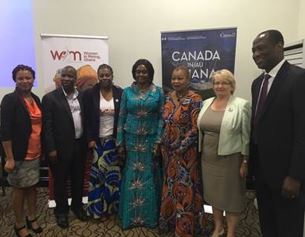
The High Commission of Canada to Ghana hosted a workshop on women in mining, which saw trade and international assistance staff work closely together on drafting speeches and tweets to promote women’s economic empowerment, training, and advocacy for women’s rights in the mining sector.
Additional examples of coherent efforts

Example 1:
Trade and Development Nexus: Impact’s Just GOLD Project
Global Affairs Canada’s engagement on responsible sourcing of minerals is a strong example of policy coherence. For instance, Canada has been engaged actively in annual OECD fora on responsible minerals supply chains and on standard setting with the OECD Due Diligence Guidance for Responsible Mineral Supply Chains.
Concurrently, Canada’s efforts to advance international standards is mirrored in Sub-Saharan Africa Branch’s development assistance funding to IMPACT, a Canadian civil society organization. In partnership with a private sector company specializing in encryption technology and fair trade jeweller in Canada, IMPACT has piloted a fully-traceable, responsible supply chain for artisan-mined gold from conflict-affected areas of DRC, which is spurring efforts to replicate the model for other commodities.
Canada’s support is demonstrating that a responsibly-sourced supply chain can be fully traceable and commercially viable, as well as have positive socioeconomic impacts on local communities, in particular for women.
Example 2:
Demonstrating the Potential of the Development-Trade Nexus
Fio Corporation’s Fionet system is an example of how Canadian companies can deploy innovative technologies in developing countries in a manner that is consistent with Canada’s Feminist International Assistance Policy and the UN Sustainable Development Goals.
Fio Corporation, a Toronto-based client of Global Affairs Canada’s Trade Commissioner Service (TCS), is at the forefront of innovative healthcare technology in developing countries. The company developed, and is now globally marketing, a system that guides health care workers through healthcare delivery protocols while simultaneously capturing vital patient information.
Fio Corporation has projects in 12 countries, including Ethiopia, Ghana, Kenya, Nigeria, Tanzania and Uganda, where the Fionet system is said to have had tangible impacts on the quality and economics of healthcare.
Their work in Sub-Saharan Africa benefits some of the world’s poorest people, including those in three of Canada’s countries of focus for international development efforts. In addition, their work is aligned with Canada’s trade and investment goals for Africa, namely to:
- Open new markets to increase opportunities for Canadian exports; and
- Enhance Canada’s reputation as a world-class corporate citizen committed to sharing knowledge and expertise.
Capitalizing on such opportunities would benefit Canada’s development, economic and trade relations, in addition to helping some of the world’s poorest and most vulnerable people. Doing so efficiently would require strategic cross-stream collaboration between trade and development.
Finding 11. Innovative practices and projects have been introduced at both HQ and missions to stimulate collaboration and foster mutually beneficial relationships across business lines.
A number of innovative initiatives, practices and products were introduced by the WGM Branch throughout the evaluation reference period to promote integration and support cross-stream collaboration, both at HQ and missions in the region.
Innovative Practices Fostering Coherence at HQ:
- In 2014, the Pan-Africa Affairs Division hosted a working group with colleagues from all three business lines to identify opportunities to enhance the culture of innovation within the Branch and harness innovative ways of working.
- Pan-Africa Affairs collaborated with the Mission Support Division (NMS) to implement coordinated digital advocacy campaigns across the region on thematic areas of relevance to development, trade and diplomacy.
- An innovation narrative was developed in 2018 to showcase innovation across all business lines. A cross-stream innovation panel was also presented at an extended Branch Management Group meeting to share innovation-focussed best practices. A cross-stream network was established by the Pan-Africa Strategic Operations and Coordination Division to share tools and best practices.
- The Branch recognized the innovative efforts of its staff through a WGM award which provided incentives for staff to pursue further innovative practices.
The Pan-Africa and Regional Development Program Division in the Pan-Africa Bureau received the Departmental award for innovation for its work on renewable energy. The division led an innovative financing project in support of the Africa Renewable Energy Initiative with 15 different groups across the Department. With an unconditional repayable contribution of $150 million, the International Finance Corporation will catalyze private sector investment in renewable energy. A separate grant will support projects in off-grid energy access that focus on underserved populations, and that can close gender gaps in the renewable energy sector.
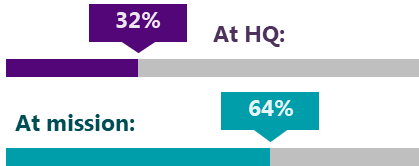
Text version
Two separate progress bar infographics are used to demonstrate that 32% of survey respondents agree that innovative practices, processes or ways of working have been fostered at headquarters, while 64% agree that they have been fostered at missions abroad.
Proportion of survey respondents who agreed that innovative practices, processes or ways of working have been fostered at missions and HQ:
The lower percentage of survey respondents who agreed that innovation had been fostered at HQ may be attributed to HQ undertakings being aimed at fostering a broader culture of innovation. The majority of innovations implemented at missions, however, were focussed on streamlining processes and working coherently within an individual mission.
Innovative Practices Fostering Coherence at Missions
- Mission coherence was integrated into job descriptions and performance measurement agreements at missions across the region. At some missions, officers have “whole of mission” objectives included in their performance agreements.
- A “tripod alliance” with champions from diplomacy, trade and international assistance was formed at the working-level in South Africa as a forum for reactive and strategic information sharing. However, the alliance was dismantled when the individual members each rotated out of the mission.
- All staff calendars have been implemented in South Africa to track mission projects, field visits, conferences, staff leave, and upcoming events. Shared with all mission staff and relevant HQ stakeholders, these calendars provided a platform for information-sharing and collaboration.
- An internal program fair was held at Canada’s High Commission to Mozambique to raise awareness of the mandates and priorities of each business line, identify synergies, and highlight potential areas for cross-stream collaboration.
- In 2018, the International Assistance Program at the High Commission of Canada in Ghana produced a memo outlining and describing potential areas of cooperation, and proposed management of files where business lines’ priorities converged. Directed toward the HOM, this document identified relationships across business lines and described prospective and potential areas of complementarity. Most notably, this document highlighted the development-trade and development-diplomacy nexuses.
- Cross-stream sharing of human resources (surge capacity) in Ghana allowed for a more even distribution of workloads at mission, as necessary, and provided opportunities for cross-stream learning.
- Strategic cross-stream thematic discussions (i.e. on gender) involving representatives from each business line enabled mission staff in Ghana to share thematic priorities and initiatives, highlight synergies, and ensure consistent engagement in the country.
DRC’s Strategia-Based Approach to Coherence
As a result of the Strategia planning exercise, KNSHA produced a one-page Venn diagram to outline each business line’s key areas of focus and highlight areas with converging priorities.
- Trade, Diplomacy and Development are represented by intersecting circles in the diagram.
- Consular and Common Services are displayed under the other business lines to represent their role in supporting and reinforcing all mission activities and priorities.
- The diagram emphasizes whole-of-GAC/whole-of-mission overlaps (elections, the fight against corruption, women’s empowerment, and PIF Funds) requiring mission-wide engagement.
Evaluation conclusion and scorecards
Conclusion
Sub-Saharan Africa is home to some of the world’s poorest people in countries that continue to need support in building their democratic, peace, and security capacities. However, the Africa narrative is changing, with the continent now being considered one of the fastest growing economic regions in the world. The Sub-Saharan Africa Branch has made strides in responding to the evolving Africa narrative in a manner that addresses both the needs of the countries in the region, as well as Canada’s broader international priorities.
WGM staff across business lines, at both management and working levels, have taken the initiative to further promote, support and facilitate coherence, not only within the Branch but also within the Department.
At the management level, WGM has made concerted efforts over the past five years to promote coherence through a new organizational structure and by developing frameworks and strategies that highlight opportunities for cross-stream engagement. Additionally, Management has provided cross-stream learning opportunities to increase WGM staff’s awareness of the different business lines’ roles and responsibilities. The Branch has also held regular cross-stream meetings to promote communication and information sharing across the Branch.
While Branch senior management has clearly articulated their expectation that business lines should collaborate more closely, there was a perceived lack of guidance on how to operationalize such coherence given some objective challenges, such as business line-specific mandates and approaches.
The nature of the Sub-Saharan Africa Branch and its focus on international development were commensurate with its resources; however, this, along with the insufficient incentives for staff to work across business lines, was seen to limit the extent to which coherence could be achieved. Additional departmental constraints such as incompatible planning and reporting systems and processes were also quoted as disincentives for joint projects and initiatives.
While there were concrete examples of collaboration across business lines, the evaluation was unable to objectively measure whether these initiatives had led to a more efficient achievement of results. Instead, the evaluation provided a starting point for discussions on coherence at the Branch level, and has identified coherence-related best practices and challenges still to be overcome.
The evaluation found that WGM’s organizational structure, and staff’s general understanding of business lines’ roles and responsibilities have positioned the Branch to better identify and leverage synergies.
However, the lack of upstream coherence at the departmental level and the need to report to separate Deputy Ministers and on distinct PIPs for each stream were identified as limiting Senior Management’s ability to foster more effective cross-stream collaboration.
Within the Branch, decisions made by Senior Management were not always perceived as reaching the working level. Furthermore, the stronger reliance on informal communication channels at the working level presented additional challenges for maintaining corporate memory due to the high percentage of rotational staff within the Branch.
Finally, there was a strong consensus that current departmental planning, reporting, and information management systems and processes continue to present challenges for improved coherence at the Branch level.
Coherence scorecards
Key organizational elements have been assessed using scorecards that were informed by the report’s findings and sources of evidence. The below scorecards highlight areas in which the Branch has successfully positioned itself for enhanced integration, as well as those where further efforts are needed to leverage synergies and capitalize on opportunities.
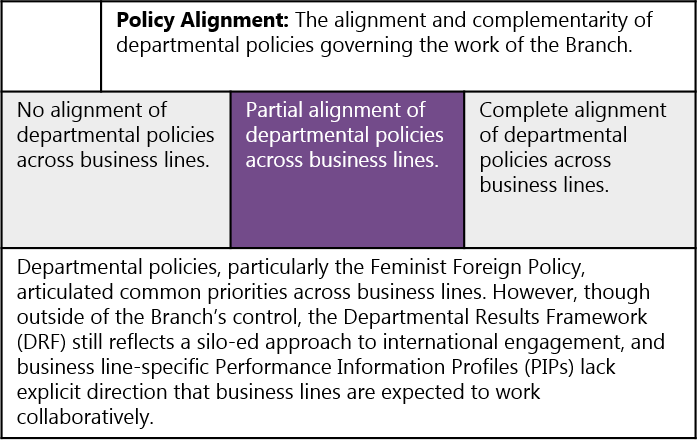
Text version
Scorecard 1: Policy Alignment
Top row of the scorecard table: The alignment and complementarity of departmental policies governing the work of the Branch.
Second row of the scorecard table: There are three potential scores that the Branch could receive for policy alignment. They are presented as three separate columns in the second row of the scorecard table:
1. Far left column - No alignment of departmental policies across business lines within the Branch.
2. Middle column - Partial alignment of departmental policies across business lines within the Branch. This box is highlighted purple to demonstrate that this is the score the Branch received.
3. Far right column - Complete alignment of departmental policies across business lines within the Branch.
The third and final row of the scorecard table: Departmental policies, particularly the Feminist Foreign Policy, articulated common priorities across business lines. However, though outside of the Branch’s control, the Departmental Results Framework (DRF) still reflects a silo-ed approach to international engagement, and business line-specific Performance Information Profiles (PIPs) lack explicit direction that business lines are expected to work collaboratively.
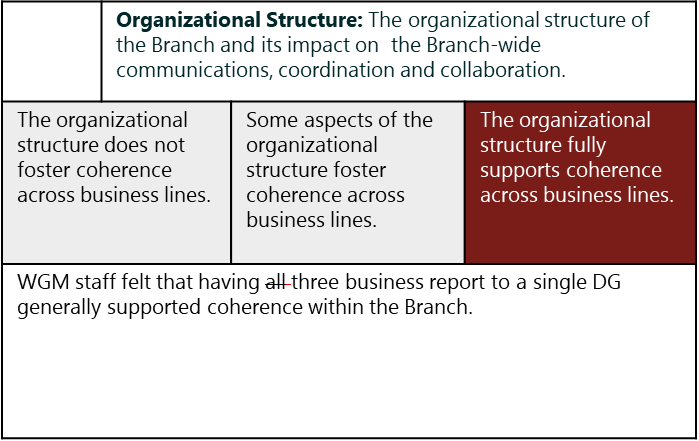
Text version
Scorecard 2: Organizational Structure
Top row of the scorecard table: The organizational structure of the Branch and its impact on the Branch-wide communications, coordination and collaboration.
Second row of the scorecard table: There are three potential scores that the Branch could receive for organizational structure. They are presented as three separate columns in the second row of the scorecard table:
1. Far left column - The organizational structure does not foster coherence across business lines.
2. Middle column - Some aspects of the organizational structure foster coherence across business lines.
3. Far right column - The organizational structure fully supports coherence across business lines. This box is highlighted maroon to demonstrate that this is the score the Branch received.
The third and final row of the scorecard table: WGM staff felt that having all three business report to a single DG generally supported coherence within the Branch.
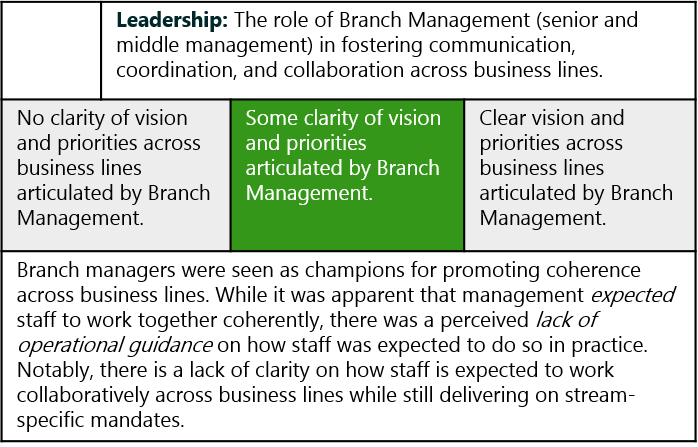
Text version
Scorecard 3: Leadership
Top row of the scorecard table: Leadership: The role of Branch Management (senior and middle management) in fostering communication, coordination, and collaboration across business lines.
Second row of the scorecard table: There are three potential scores that the Branch could receive for
leadership. They are presented as three separate columns in the second row of the scorecard table:
1. Far left column - No clarity of vision and priorities across business lines articulated by Branch Management.
2. Middle column - Some clarity of vision and priorities articulated by Branch Management. This box is highlighted green to demonstrate that this is the score the Branch received.
3. Far right column - Clear vision and priorities across business lines articulated by Branch Management.
The third and final row of the scorecard table: Branch managers were seen as champions for promoting coherence across business lines. While it was apparent that management expected staff to work together coherently, there was a perceived lack of operational guidance on how staff was expected to do so in practice. Notably, there is a lack of clarity on how staff is expected to work collaboratively across business lines while still delivering on stream-specific mandates.
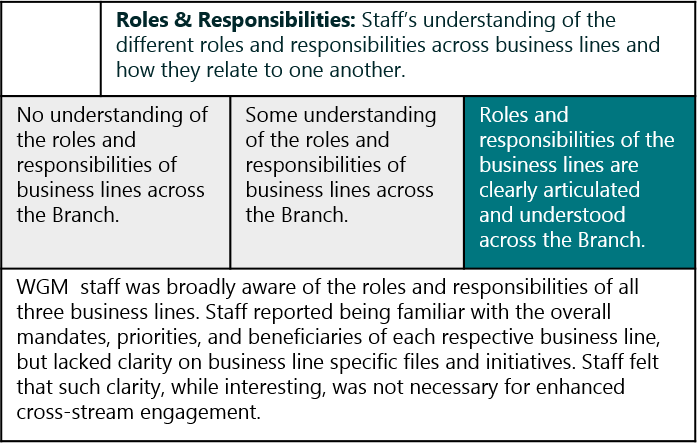
Text version
Scorecard 4: Roles and Responsibilities
Top row of the scorecard table: Roles & Responsibilities: Staff’s understanding of the different roles and responsibilities across business lines and how they relate to one another.
Second row of the scorecard table: There are three potential scores that the Branch could receive for roles and responsibilities. They are presented as three separate columns in the second row of the scorecard table:
1. Far left column - No understanding of the roles and responsibilities of business lines across the Branch.
2. Middle column - Some understanding of the roles and responsibilities of business lines across the Branch.
3. Far right column - Roles and responsibilities of the business lines are clearly articulated and understood across the Branch. This box is highlighted turquoise to demonstrate that this is the score the Branch received.
The third and final row of the scorecard table: WGM staff was broadly aware of the roles and responsibilities of all three business lines. Staff reported being familiar with the overall mandates, priorities, and beneficiaries of each respective business line, but lacked clarity on business line specific files and initiatives. Staff felt that such clarity, while interesting, was not necessary for enhanced cross-stream engagement.
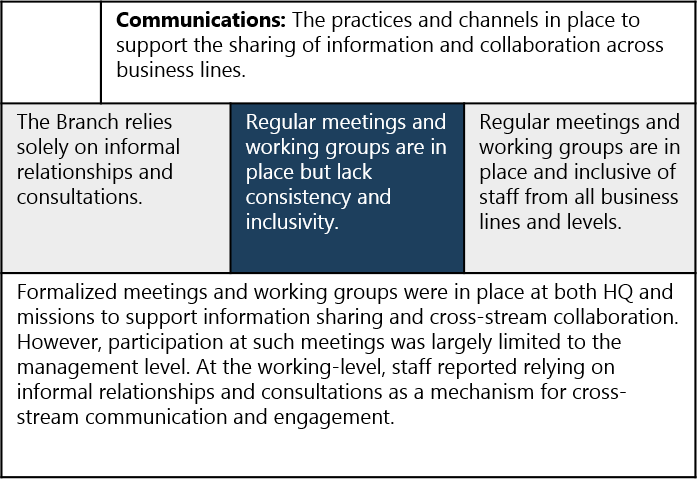
Text version
Scorecard 5: Communications
Top row of the scorecard table: Communications: The practices and channels in place to support the sharing of information and collaboration across business lines.
Second row of the scorecard table: There are three potential scores that the Branch could receive for communications. They are presented as three separate columns in the second row of the scorecard table:
1. Far left column - The Branch relies solely on informal relationships and consultations.
2. Middle column - Regular meetings and working groups are in place but lack consistency and inclusivity. This box is highlighted in navy blue to demonstrate that this is the score the Branch received.
3. Far right column - Regular meetings and working groups are in place and inclusive of staff from all business lines and levels.
The third and final row of the scorecard table: Formalized meetings and working groups were in place at both HQ and missions to support information sharing and cross-stream collaboration. However, participation at such meetings was largely limited to the management level. At the working-level, staff reported relying on informal relationships and consultations as a mechanism for cross-stream communication and engagement.
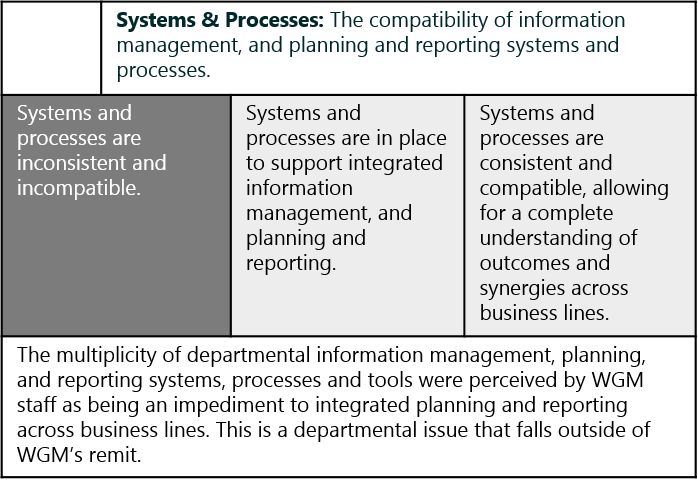
Text version
Scorecard 6: Systems & Processes
Top row of the scorecard table: Systems & Processes: The compatibility of information management, and planning and reporting systems and processes.
Second row of the scorecard table: There are three potential scores that the Branch could receive for systems and processes. They are presented as three separate columns in the second row of the scorecard table:
1. Far left column - Systems and processes are inconsistent and incompatible. This box is highlighted in grey to demonstrate that this is the score the Branch received.
2. Middle column - Systems and processes are in place to support integrated information management, and planning and reporting.
3. Far right column - Systems and processes are consistent and compatible, allowing for a complete understanding of outcomes and synergies across business lines.
The third and final row of the scorecard table: The multiplicity of departmental information management, planning, and reporting systems, processes and tools were perceived by WGM staff as being an impediment to integrated planning and reporting across business lines. This is a departmental issue that falls outside of WGM’s remit.
Areas for departmental consideration and horizontal learning
Systems, Tools and Processes: Incompatible departmental systems for information management, planning, and reporting across business lines can create silos, dis-incentivize collaboration, and impact the ability to capture results on joint-efforts. Department-wide efforts toward harmonizing and streamlining planning and reporting processes across business lines are needed.
Cross-Stream Opportunities: Opportunities for cross-stream temporary assignments and postings promote greater awareness and deeper appreciation for collaboration across business lines. Stream-specific expertise, skills and knowledge can inspire innovation and the leveraging of synergies in other areas. Professional development and learning opportunities across business lines were deemed important for cross-stream collaboration
Approval Processes: Lengthy project approval processes and short turnaround times for input have an impact on the ability of business lines to engage in meaningful consultations, joint planning and the identification of opportunities for collaboration. Branches across the Department need to take into consideration the time required to allow for coherent engagement.
Approach to Coherence: The complexity of promoting coherence within a branch means that it will not develop organically. Movement toward organizational coherence requires a systematic and comprehensive approach that fosters integration and synergies across business lines. Without a concerted effort, opportunities will be missed.
Organizational Structures: Organizational structures play a key role in fostering of coherence across business lines. However, the siloing that remains at the departmental level presents a challenge for effective collaboration across streams at the branch level.
Rotation and Mobility of Staff: While rotation and mobility of staff can promote the sharing of best practices and learning across business lines, it can also have a negative effect on corporate memory and coherence given the high-turnover of staff.
Evaluation recommendations
It is recommended that WGM Senior Management:
- Continue to reinforce Branch-wide expectations of cross-stream engagement, and to communicate to all staff a shared vision of how these expectations are to be operationalized.
- Continue to plan and implement initiatives that foster and incentivize cross-stream learning and innovation across the Branch.
- Collect results on joint efforts to better enable the identification of synergies achieved in the Branch and feed this into the WGM Data Plan.
Management response and action plan
Recommendation 1:
It is recommended that WGM Senior Management continue to reinforce Branch-wide expectations of cross-stream engagement, and communicate to all staff a shared vision of how these expectations are to be operationalized.
Branch Response: Agreed. As the evaluation highlights, Sub-Saharan Africa Branch has made concerted efforts over the years to promote integration across business lines. With annual rotations of GAC staff, there is an opportunity to continuously reinforce expectations at Branch management and working levels. WGM Senior Management will:
- Share 2020-21 Branch planning commitments across streams with all staff, and reinforce expectations for cross-stream collaboration.
- Lead Division/Bureau: WFO
- Timeline for Implementation: Fully implemented
- Ensure coherence is reflected in mandate letters of Heads of Mission and Heads of Cooperation, and ensure they are shared with staff, along with operational guidance on expectations for cross-stream engagement.
- Lead Division/Bureau: WWD/WED/WFD
- Timeline for Implementation: By October 2020
Recommendation 2:
It is recommended that WGM Senior Management continue to plan and implement initiatives that foster and incentivize cross-stream learning and innovation across the Branch.
Branch Response: Agreed. WGM Senior Management is committed to continuing to foster an environment of collaboration, and will further develop and amplify initiatives that foster cross stream collaboration. WGM Senior Management will:
- Engage with extended Branch Management Group to identify priority training needs that foster cross-stream learning, and deliver training to staff.
- Lead Division/Bureau: WFR/WFO
- Timeline for Implementation: By September 2021
- Establish a development-trade field officer pilot position to promote increased opportunities for the development-trade nexus in the region.
- Lead Division/Bureau: WFD
- Timeline for Implementation: By September 2021
- Establish a WGM award for cross-stream coherence and present winning submissions at bi-annual all-staff event.
- Lead Division/Bureau: WFO
- Timeline for Implementation: By December 2020
- Update the Branch innovation narrative and develop a repository of coherence good practices and circulate to all staff to foster cross-stream learning.
- Lead Division/Bureau: WFO
- Timeline for Implementation: Fully implemented
Recommendation 3:
It is recommended that WGM Senior Management collect results on joint efforts to better enable the identification of synergies achieved in the Branch and feed this into the WGM Data Plan.
Branch Response: Agreed. WGM Senior Management will:
- Engage missions to report on initiatives and results of coherence efforts in Strategia 2019-20, to feed into the Performance and Results pillar of WGM Data Plan.
- Lead Division/Bureau: WFO
- Timeline for Implementation: By December 2020